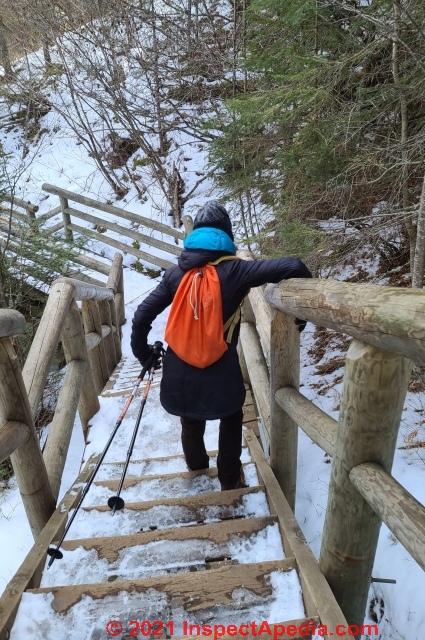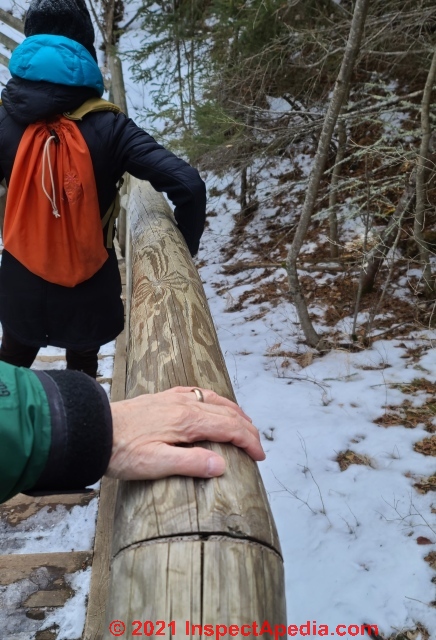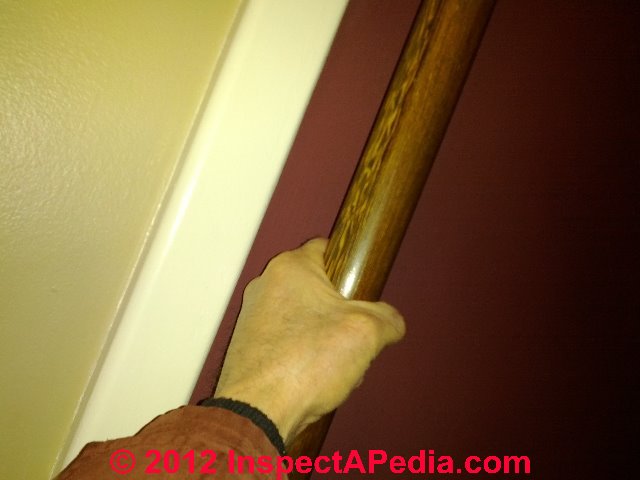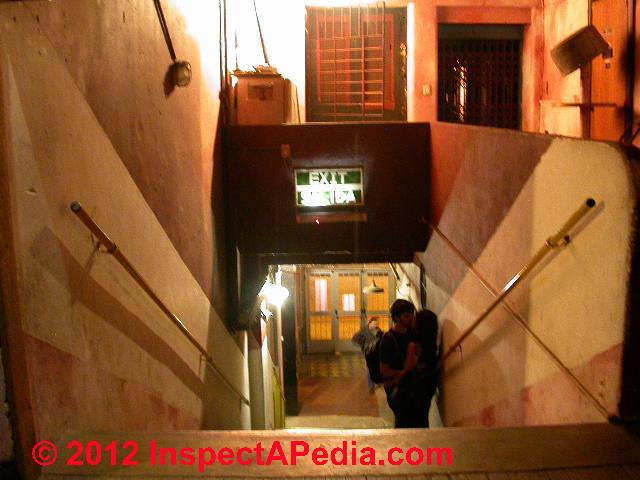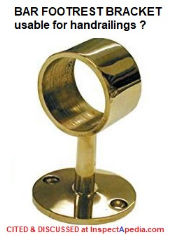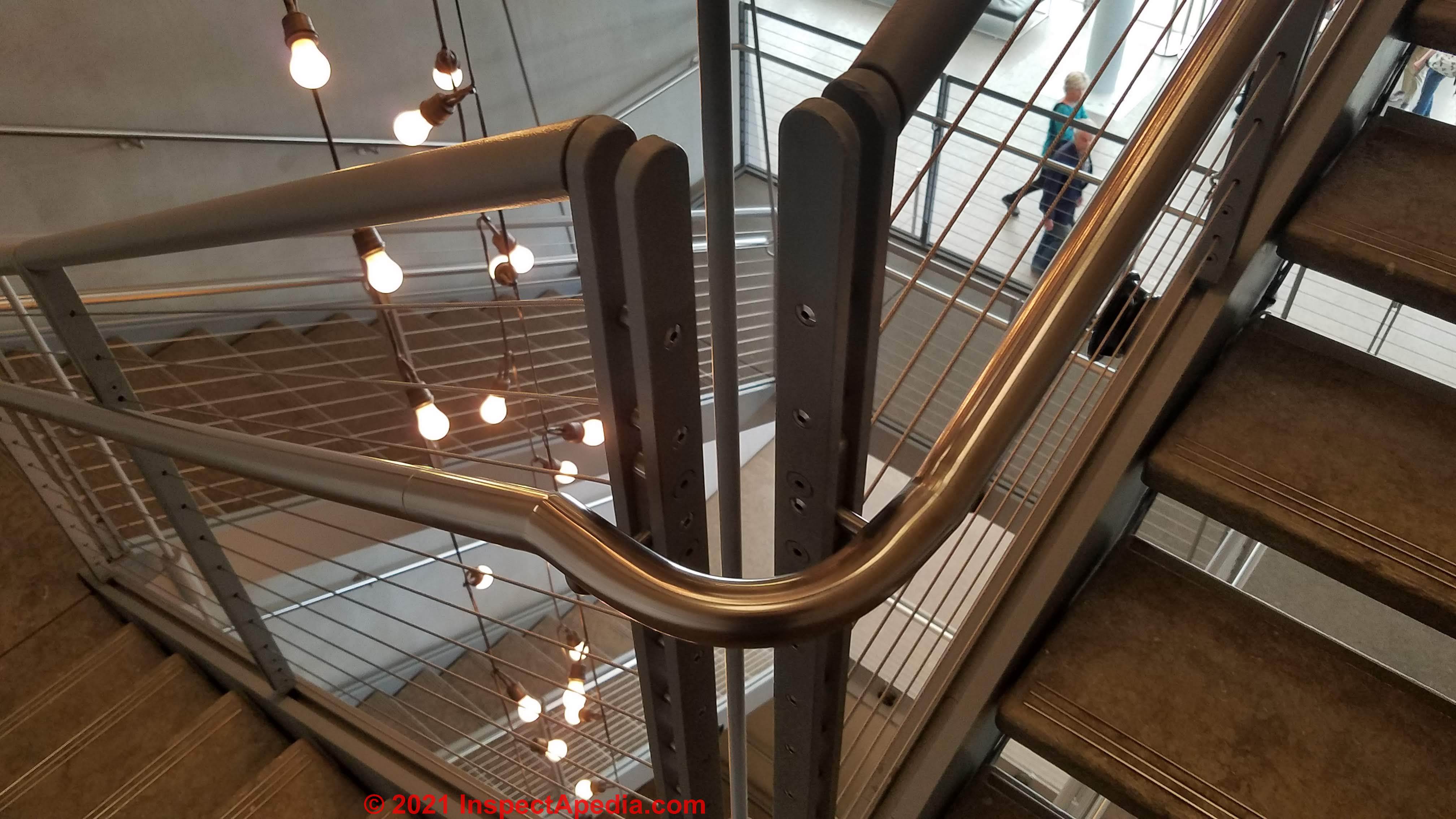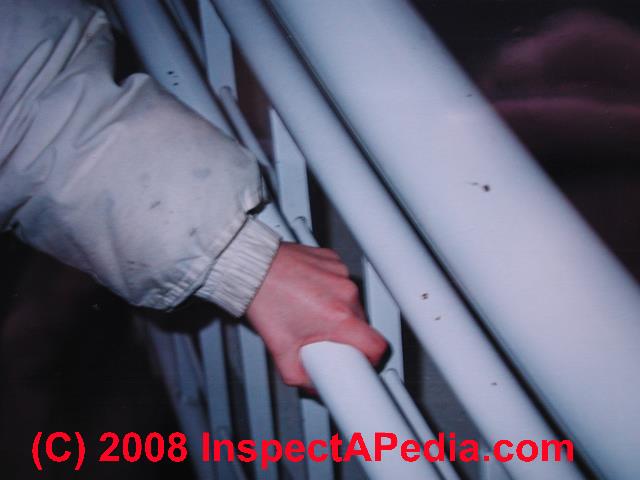 Handrailing Graspability
Handrailing Graspability
The ability to obtain a secure hold on handrailings is essential in fall prevention
- POST a QUESTION or COMMENT on the graspability or hand-hold capability of building handrails
Handrailing graspability: this article explains and illustrate the requirements for graspable handrails & railings used inside or outside buildings, including guardrails, hand railings on steps and stairs, and stair rails or stair guards for both interior and exterior stairways. used on stairs, balconies, decks, ramps, walks.
We include descriptions & definitions of graspability for handrailings, and we illustrate safe and unsafe, graspable and not-graspable handrailings in sketches, photographs, and building code citations.
This article series provides building code specifications, sketches, photographs, and examples of stair & railing safety defects used in inspecting indoor or outdoor stair railings or handrails and related conditions for safety and proper construction.
InspectAPedia tolerates no conflicts of interest. We have no relationship with advertisers, products, or services discussed at this website.
- Daniel Friedman, Publisher/Editor/Author - See WHO ARE WE?
Hold On! Handrailing & Railing Graspability Requirements, Codes, Hazards
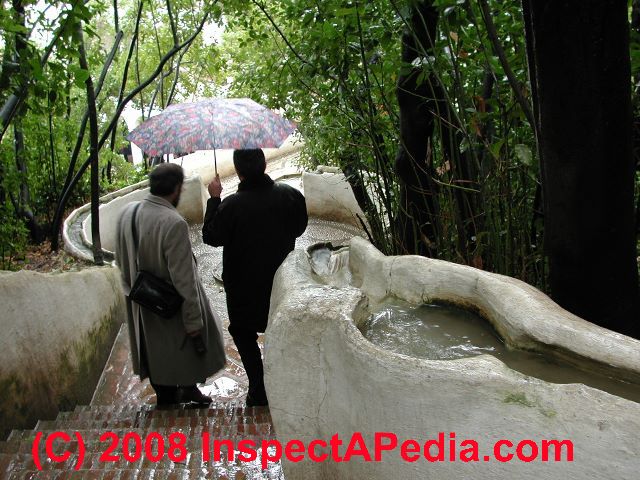
The intent of a handrail is to provide a handgrip for people using a stairway. If a railing cannot be securely gripped it is unsafe.
While graspability of handrails naturally focuses on the profile or shape and dimensions of a handrailing, the spacing of the handrail from the wall, its height, continuity, and other features also will interfere with the ability of a person to securely grasp a handrailing when she wants to or needs to in an effort to prevent or arrest a fall.
Shown above/left: a water-filled handrailing along a stairway at the Alhambra in Spain. Beautiful, this handrailing reflects the Moorish affection for water. It's not a great handrailing to prevent a fall.
Definition: Graspability of a handrail refers to the ability to get a secure hold onto a handrailing whose purpose, after all, is both to guide a walker along a stair or other surface and to prevent or perhaps to interrupt slip trip and fall hazards.
Profiles & Dimensions of Graspable Handrailings
Dimension Specifications for Graspable Handrails: recap
- Railing grip size and shape: (must be able to be grasped)
- Round rails: between 1.25" and 2" in diameter
- Metal ogee shaped: <= 2.25" across widest dimension
- Wood oblate shaped: <= 2.25" across widest dimension
- Rectangular shaped: perimeter must be between 4" and 6.25"
- Perimeter larger than 6" must have a graspable finger recess (see details at the ASM document link below)
If the horizontal profile of a stairway handrailing is too fat (we give an example below, thumb grooves help but don't eliminate the hazard - for oversized stair rails simply can't be grasped securely.
These two sketches (above and below) are found in the California Building Code for stairs and railings [37].
Reader Question: are 2" diameter PVC handrailings acceptable?
[Click to enlarge any image]
Is 2” PVC piping allowed to be used as a stairway handrail in a school building?
Thanks,
John [by private email] 2016/03/21
Reply:
I don't think codes specify materials, John, rather dimensions, strength, etc.
The two-inch diameter of the PVC pipe is acceptable in terms of graspability as we see in this article.
Watch out: however in my opinion, long runs of un-supported PVC piping may be too flexible or may sag too much to be safely graspable and safely rigid to support a stairway user in the event of a fall. So while the diameter of the pipe may be fine, unless the piping is supported at intervals sufficiently close to keep it rigid and straight it may not form a good railing.
Type II Residential Handrails - for perimeter larger than 6 1/4"
Some (not all) codes allow handrails that have an overall perimeter greater than 6 1/4", most commonly to permit use of 2x lumber to construct handrails. However in these larger sizes, the handrail must have a thumb and finger groove; Some older codes may permit the 2x6 handrail profile at far left in the illustration below, but as of 2009 the handrail needs a groove on both sides.
The intent of the finger and thumb groove is to provide equivalent graspability as might be obtained on a round 2-inch handrail. (The 2-inch handrail is allowed by all U.S. building codes.)

Watch out: No model building code and no other building code that we have surveyed permitted 2x6 or even 2x4 handrailings installed "on the flat" as a safe graspable stair handrail system. The two sketches here illustrate graspable (and X'd out non-graspable) handrailing profiles.
The IRC and residential portion of the 2009 IBC define Type II handrail as follows:
Type II. Handrails with a perimeter greater than 6¼ inches (160 mm) shall provide a graspable finger recess area on both sides of the profile.
The finger recess shall begin within a distance of 3/4 inch (19 mm) measured vertically from the tallest portion of the profile and achieve a depth of at least 5/16 inch (8 mm) within 7/8 inch (22 mm) below the widest portion of the profile. This required depth shall continue for at least 3/8 inch (10mm) to a level that is not less than 1¾ inches (45 mm) below the tallest portion of the profile.
The minimum width of the handrail above the recess shall be 1¼ inches (32 mm) to a maximum of 2¾ inches (70 mm). Edges shall have a minimum radius of 0.01 inch (0.25 mm).
The California stair codes model the Uniform Building Code UBC 1003.3.3.6 1997 or later. Below are additional excerpts from the IRC, IBC, and Florida handrail codes:
The non-circular handrail profile shown above is illustrated in the Florida Handrail code at 505.7.2. where the additional details are specified:
505.7.1 Circular Cross Section [handrailings].
Handrail gripping surfaces with a circular cross section shall have an outside diameter of 1 1/4 inches (32 mm) minimum and 2 inches (51 mm) maximum
505.7.2 Non-Circular Cross Sections [handrailings].
Handrail gripping surfaces with a non-circular cross section shall have a perimeter dimension of 4 inches (100 mm) minimum and 6 1/4
inches (160 mm) maximum, and a cross-section dimension of 2 1/
4
inches (57
mm) maximum.
505.8 Surfaces: Handrail gripping surfaces and any surfaces adjacent to them shall be free of sharp or abrasive elements and shall have rounded edges.
505.9 Fittings: handrails shall not rotate within their fittings
Thanks to reader M.S. for careful editing and correcting of the graspable handrail diameter, 9/17/2013 - Ed.
How Unsafe or Non-Functional Handrails & Stair Railings Contribute to Stair Falls & Injuries
Photo: the very fat "handrail" along these stairs in northern Minnesota illustrates just how unsafe a non-graspable handrailing might be. Along these ice-covered steps the walker tries to prevent a fall by wrapping her entire arm around the handrail as it is far too large to grasp with one's hand
Summary of Common Causes of Non-Graspable or Unsafe Handrails
A handrailing may be non-graspable for many reasons but most commonly because of these handrailing safety defects:
- Location: Handrailing location: too low, too high along the stairway
- Missing: Handrailing is missing where required
- Obstructed: Handrailing obstructions: interruptions, blockages to access
- Shape: Handrailing shape: profile cannot be securely grasped
- Size: Handrailing size: too big or too small to grasp comfortably
- Spacing: Handrailing spacing: too close to wall to grasp, too far from wall projecting into stair passage
- Strength: Handrailings are not strong enough to withstand loads of a person holding-on or grasping when falling
- Surface: Handrailing surface: icy, sharp, splinters
- Winder or curved stair blockage: handrailings should include features to prevent people from walking along the portion of angular stair treads that are too small and thus unsafe
Don't Underestimate the Importance of Railings on Stairs
Opinion: Daniel Friedman. The following opinions derive the author's experience in building stairs, inspecting stairs in and at buildings, in researching stair construction practices & building codes, and in the occasional assistance in the investigation of stair falls.
While it is readily apparent that a loose, broken, or defective guardrail on a deck, balcony, or landing can contribute to or even cause a bad fall, we sometimes find that the role of the stair handrail in stair fall injuries is underestimated or missed entirely by people investigating such accidents.
The proper construction and physical condition of the handrailing at any stairway should be an important part of the investigation conducted to understand the cause & extent of stair falls and fall-related injuries.
At left our photo shows a stair handrailing that is functional and graspable. But what if the railing is one that is improperly located, secured, sized or shaped?
Because a defective stairway handrailing denies the stair user an opportunity to arrest or reduce the extent of a fall, non-functional handrailings are a significant contributor to the both the occurrence of the fall down stairs and the severity of the fall.
A stair fall can be initiated by many conditions or events, some related to the condition of a tread or walking surface (slippery, uneven, sloped, loose, gaps, knots, rot, breakaways, bad lighting) but also to other more independent causes (person is running and missteps, person trips over own shoelace).
But as a general rule, when a stair fall occurs the existence of the railing and its condition take on a very important role in stopping the fall or reducing its extent.
In that circumstance, an improper or unsafe railing is in one sense, worse than had there been no handrailing present at all, since in the latter case a stair user will have observed that there was no railing and may have been inclined to move more slowly and with greater care without that security, just as we are not inclined to step to the very edge of a tall balcony if no railings are installed on its perimeter.
Our photo above illustrates a stair railing that is much to large to be securely grasped.
Our friend Asta S., visiting el Nigromante Art and Cultural Center in San Miguel de Allende, Mexico, is illustrating the extent of this oversized stair rail - just compare the size of her hand to the railing size. This handrail might help to steady someone walking up or down the stairs as one can place a hand on the railing. But in a fall this railing is worthless.
A person using stairs often does not think at all about railings and may not even touch them - until a fall begins. At that moment there is an instinct to "grab on" to something to try to arrest the fall or at least to reduce its severity.
At the start of a fall up or down stairs, people will drop packages or even throw them into the air in the process of trying by instinct to grab onto a railing. The reach for a secure hand-hold in in such moments is rapid and the opportunity to obtain a secure grasp to stop a stair fall is brief, giving import to the term readily graspable handrails.
Building Codes Specifying Hand Railing Graspability Requirements
Please see the following stair code articles:
A Photo Guide to Unsafe & Unacceptable Handrail Dimensions & Shape -
We moved this discussion to a separate article now at HANDRAIL GRASPABILITY DEFECT PHOTOS
Above: the couple of tangueros we found smooching on these stairs in Buenos Aires, Argentina were grasping one another so tightly that neither of them cared a hoot about the graspability of the handrailing in their stairwell.
Handrail Continuity: In What Locations Must Handrailings Must Be Continuous to Be Considered Fully Graspable?
We've moved this to a separate article. Please
see HANDRAIL CONTINUITY. In general, stairway handrailings should be continuously graspable along the run of the stair and in most situations the railing should continue around intermediate stairway landings.
...
Reader Comments, Questions & Answers About The Article Above
Below you will find questions and answers previously posted on this page at its page bottom reader comment box.
Reader Q&A - also see RECOMMENDED ARTICLES & FAQs
Is there a the vertical minimum requirement for graspability of handrails?
Thanks for all the insight! Is there a the vertical minimum requirement for handrails?
For example, if I used this bracket to hold a 1.5" or 2"rail (you can see it sticks straight out from wall instead of bending up), would it pass the inspection for graspability? - On 2019-10-10 by Rob
PS:
I think it is marketed as a bar foot rest rail bracket, but it is very difficult to find ring brackets that curve up and cover enough of the seam for my application. I am using lucite hand rails.Reply by (mod) - That bracket used to support a bar footrest may interfere with continuous graspability of a handrailing
Rob
We can know whether your local Building Code Compliance inspector is going to accept that design or not. They are the final legal Authority. Question, is that bracket actually being marketed as a hand railing bracket?I kind of thought that looked like a foot rest bracket. What I have done in this situation is to have the brackets fabricated to the appearance that I wanted. I would do a bit more looking if you don't want to go that route.
If a handrail makes a 90 degree bend along the stair run, is that considered to be continuous
If a handrail makes a 90 degree bend along the stair run, is that considered to be continuous - On 2019-05-10 by kakReply by (mod) - Continuity of handrail around corners & landings
Yes Kak as long as it's actually continuous - that is, the turn isn't interrupted by space.
Actually a nicer, more-graspable handrail would use a radius curve rather than a 90 degree turn.
Shown below is a nicely-curved-radius handrail that I photographed yesterday at the Whitney Museum in NY City.
Can we add tape to make a handrail "graspable" ?
If you are purchasing a handrail and it doesn't meet code for graspability (i.e. the perimeter is slightly greater than what is allowed and it doesn't have a recessed area (its flat all the way down)) then what can be done? Can you for example apply some textured tape to make it more grippable? - On 2018-05-04 by JohnReply by (mod) -
I don't think-so, John. Adding tape might increase the graspability of a surface, but if the handrail is already too large, adding tape makes it slightly larger still.
I would prefer to use a handrailing with a graspable-profile and in the recommended size range given by the experts.
I ***Speculate*** that if by "slightly greater" size, your handrail size is maybe a 1/4" off, nobody will notice or care - until there's a fall and a lawsuit.
...
Continue reading at HANDRAIL CODES - GRASPABILITY or select a topic from the closely-related articles below, or see the complete ARTICLE INDEX.
Or see these
Recommended Articles
- GUARDRAILS on STAIRS, DESIGN
- HANDRAILS & HANDRAILINGS
- FALL HAZARDS DUE TO UN-GRASPABLE HANDRAILS
- GRASPABILITY of HANDRAILINGS
- HANDRAIL CODES & OSHA HAND RAIL SPECS
- HANDRAIL CODES - GRASPABILITY
- HANDRAIL CONTINUITY
- HANDRAIL EXTENSION REQUIREMENTS
- HANDRAIL GRASPABILITY DEFECT PHOTOS
- HANDRAILING STRENGTH
- HANDRAILS for WIDE STAIRWAYS
- SNAG HAZARDS on STAIRWAYS
- RAILING CODES & STANDARDS - home
- STAIR CODES & STANDARDS - home
- STAIR CODE DETAILS
Suggested citation for this web page
GRASPABILITY of HANDRAILINGS at InspectApedia.com - online encyclopedia of building & environmental inspection, testing, diagnosis, repair, & problem prevention advice.
Or see this
INDEX to RELATED ARTICLES: ARTICLE INDEX to STAIRS RAILINGS LANDINGS RAMPS
Or use the SEARCH BOX found below to Ask a Question or Search InspectApedia
Ask a Question or Search InspectApedia
Try the search box just below, or if you prefer, post a question or comment in the Comments box below and we will respond promptly.
Search the InspectApedia website
Note: appearance of your Comment below may be delayed: if your comment contains an image, photograph, web link, or text that looks to the software as if it might be a web link, your posting will appear after it has been approved by a moderator. Apologies for the delay.
Only one image can be added per comment but you can post as many comments, and therefore images, as you like.
You will not receive a notification when a response to your question has been posted.
Please bookmark this page to make it easy for you to check back for our response.
IF above you see "Comment Form is loading comments..." then COMMENT BOX - countable.ca / bawkbox.com IS NOT WORKING.
In any case you are welcome to send an email directly to us at InspectApedia.com at editor@inspectApedia.com
We'll reply to you directly. Please help us help you by noting, in your email, the URL of the InspectApedia page where you wanted to comment.
Citations & References
In addition to any citations in the article above, a full list is available on request.
- M.S. [reader] personal correspondence, 9/17/2013, corrected a typographical error in our specification of the minimum outside diameter of a graspable handrailing - Ed.
- Thanks to reader Craig Sharp who contributed technical review & clarifications regarding the distinctions among handrailing, stair rail and guardrail 2/1/2-13.
- Decks and Porches, the JLC Guide to, Best Practices for Outdoor Spaces, Steve Bliss (Editor), The Journal of Light Construction, Williston VT, 2010 ISBN 10: 1-928580-42-4, ISBN 13: 978-1-928580-42-3, available from Amazon.com
- In addition to citations & references found in this article, see the research citations given at the end of the related articles found at our suggested
CONTINUE READING or RECOMMENDED ARTICLES.
- Carson, Dunlop & Associates Ltd., 120 Carlton Street Suite 407, Toronto ON M5A 4K2. Tel: (416) 964-9415 1-800-268-7070 Email: info@carsondunlop.com. Alan Carson is a past president of ASHI, the American Society of Home Inspectors.
Thanks to Alan Carson and Bob Dunlop, for permission for InspectAPedia to use text excerpts from The HOME REFERENCE BOOK - the Encyclopedia of Homes and to use illustrations from The ILLUSTRATED HOME .
Carson Dunlop Associates provides extensive home inspection education and report writing material. In gratitude we provide links to tsome Carson Dunlop Associates products and services.





